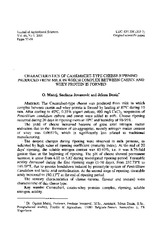Приказ основних података о документу
Characteristics of Camembert-type cheese ripening produced from milk in which complex between casein and whey protein is formed
Karakteristike zrenja sira tipa Kamambera proizvedenog od mleka kod koga je obrazovan kompleks između kazeina i serum proteina
| dc.creator | Maćej, Ognjen | |
| dc.creator | Jovanović, Snežana | |
| dc.creator | Denin, Jelena D. | |
| dc.date.accessioned | 2020-12-17T17:47:56Z | |
| dc.date.available | 2020-12-17T17:47:56Z | |
| dc.date.issued | 2001 | |
| dc.identifier.issn | 1450-8109 | |
| dc.identifier.uri | http://aspace.agrif.bg.ac.rs/handle/123456789/295 | |
| dc.description.abstract | The Camembert-type cheese was produced from milk in which complex between casein and whey protein is formed by heating at 87°C during 10 min. After cooling to 40°C, 0.35% yogurt culture, 400 mg/1 CaCl2, suspension of Penicillium candidum culture and rennet were added to milk. Cheese ripening occurred during 20 days in ripening room at 10°C and humidity of 90-95%. The yield of cheese increased because of great total nitrogen matter utilisation due to the formation of co-aggregates, namely nitrogen matter content of whey was 0.0651%, which is significantly less related to traditional manufacturing. The deepest changes during ripening were observed in milk proteins, as indicated by high value of ripening coefficient (maturity index). At the end of 20 days' ripening, the soluble nitrogen content was 83.97%, i.e. it was 8.76-fold greater than at the beginning of ripening. The pH of cheese showed permanent increase, it arose from 4.02 to 5.82 during investigated ripening period. Titratable acidity decreased during the first ripening stage (1-10 days), from 237.73T to 146.18°T, due to protein breakdown induced by proteolytic system of Penicillium Candidum and lactic acid neutralization. At the second stage of ripening, titratable acidy increased to 190.13°T at the end of ripening period. The sensory characteristics of cheese (aroma, flavour and texture) were characteristic of this cheese type. | en |
| dc.description.abstract | Sir tipa Kamamber proizveden je od mleka kod kojeg je zagrevanjem na temperaturi od 87°C u toku 10 minuta obrazovan kompleks između kazeina i serum proteina. Na temperaturi od 40°C dodato je 0.35% jogurtne kulture, 400 mg/1 CaCl2, suspenzija Penicilium candidum i sirilo. Zrenje sira je bilo na temperaturi od 10°C, pri relativnoj vlažnosti od 90-95%, u vremenu od 20 dana. Sadržaj azota u surutki iznosio je 0.0651% i bio je manji u odnosu na surutku koja se dobija pri tradicionalnoj proizvodnji sireva, što je imalo za posledicu i veći randman. Najdublje promene za vreme zrenja odvijale su se na proteinima. Nakon 20 dana zrenja sadržaj rastvorljivog azota u ukupnom azotu iznosio je 83.97% i bio 8.76 puta veći u odnosu na prvi dan zrenja. Kao rezultat izraženih proteolitičkih procesa i pH vrednost sira se permanentno povećavala. Na kraju ispitivanog perioda zrenja pH vrednost sira je iznosila 5.82. Senzorne karakteristike sira (ukus, miris, konzistencija) bile su karakteristične za ovu vrstu sira. | sr |
| dc.publisher | Univerzitet u Beogradu - Poljoprivredni fakultet, Beograd | |
| dc.rights | openAccess | |
| dc.rights.uri | https://creativecommons.org/licenses/by-sa/4.0/ | |
| dc.source | Journal of Agricultural Sciences (Belgrade) | |
| dc.subject | camembert | en |
| dc.subject | casein-whey proteins complex | en |
| dc.subject | ripening | en |
| dc.subject | soluble nitrogen | en |
| dc.subject | acidity | en |
| dc.title | Characteristics of Camembert-type cheese ripening produced from milk in which complex between casein and whey protein is formed | en |
| dc.title | Karakteristike zrenja sira tipa Kamambera proizvedenog od mleka kod koga je obrazovan kompleks između kazeina i serum proteina | sr |
| dc.type | article | |
| dc.rights.license | BY-SA | |
| dc.citation.epage | 69 | |
| dc.citation.issue | 1 | |
| dc.citation.other | 46(1): 57-69 | |
| dc.citation.spage | 57 | |
| dc.citation.volume | 46 | |
| dc.identifier.fulltext | http://aspace.agrif.bg.ac.rs/bitstream/id/1599/292.pdf | |
| dc.identifier.rcub | https://hdl.handle.net/21.15107/rcub_agrospace_295 | |
| dc.type.version | publishedVersion |


